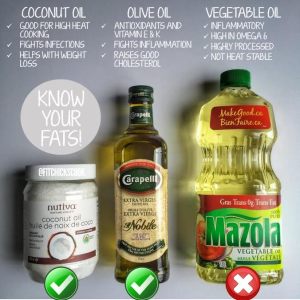|
Fat loss has been a goal for many in the fitness community, generally summed up as “I want to lose more body fat and gain muscle”. Well, one method of fat loss is minimizing your fat intake. Gram-for-gram, dietary fat has more calories than protein and carbs so it’s a macro that’s easy too overeat. But… not all fats are created equal so there’s important distinctions to be made between the three types of fat: saturated, monounsaturated and polyunsaturated. Also, dietary fat are a contentious subject, so today I’m gonna keep it simple and stick to 3 types of oils representing the three broad categories of dietary fats. I usually stick to just coconut oil for higher heat cooking and olive oil for salad or lower heat cooking. I’ll go into reasons below! Coconut Oil
It has gotten a bad rep in the past because of the high levels of saturated fat (about 90% of calories are from saturated fat). But in recent years, saturated has been proven to not be the boogeyman it was made out to be and is in fact a smart addition to your diet. In fact, populations that eat a lot of coconut oil are generally healthier than ones that don’t. Because 90% of the fatty acids are from saturated fat, coconut oil is highly resistant to oxidation at high heats (not a good idea to eat anything that’s oxidized or rancid). For this reason, if I cook anything on high heat, I’ll use coconut oil. There can be a slight coconut taste when using this as a cooking oil, but buying the “refined” option will solve this. Did you know that the fatty acids in coconut oil can increase energy expenditure, improve satiety and help you lose weight! It’s definitely a super healthy fat. Bottom line: coconut oil is a great cooking oil at a high heat because they are stable and don’t oxidize or go rancid easily, and is a great source of healthy fats. Olive Oil Olive oil is simply made by pressing olives and is made up of about 70% monounsaturated fat and has all sorts of healthy benefits. However, this type of fat is not quite as heat-stable as coconut oil (saturated fats). Therefore, the best type of olive oil is cold-pressed extra virgin olive oil (EVOO) because it’s the purest form and made with low heat processing that minimizes the chances of oxidization. I normally use EVOO for all of my cold dishes if I’m baking something in 350 degrees or lower. It is a great oil because it can raise good HDL cholesterol and lower the bad LDL. It is also high in antioxidants and a good source of vitamin E and K. Olive oil can also fight inflammation, which is believed to be the cause of many serious diseases. Bottom line is that olive oil can be one of the healthiest fats to consume and great for cooking. But be careful when selecting which one to buy because there are lots of “olive oil blends” out there that are not pure olive oil. So read your labels! I always stick with EVOO and ensure that the ingredients clearly state that it’s made with “100% olives”. Vegetable Oil Basically avoid this all together. Why? This oil (along with canola, grape seed and sunflower oils) primarily consist of polyunsaturated fat and are highly processed and refined and they are really high in omega 6. They were considered “heart-healthy” for years because of the bad science surrounding saturated fat and the boogeyman it was made out to be and the supposed healthy alternative that it presented because of it’s low saturated fat content. However, current research has linked high intakes of polyunsaturated fats with some serious health effects like heart disease. Because polyunsaturated fats are high in omega 6, these fats can upset a delicate balance in your body, the result of which can be pro-inflammatory. Have you seen the way canola oil or any vegetable oil is produced? Watch “How it’s made – canola oil” on YouTube and you will be surprised. The processing of making canola oil is quite shocking and involves pressing, heating, and adding various industrial chemicals and highly toxic solvents (do you want to eat that!?) Other vegetable oils are processed in a similar manner. The worse part is that most restaurants use vegetable oils to cook because it is cheap (most restaurants care about their bottom line more than your health!) So if you eat out a lot then you might want to consider cutting back or opting for items on the menu that are not fried (grilled or steamed meats or salads). This is also the reason why we don’t eat out very often and why healthy eating starts at home cooking whole foods using the right kind of fats. So next time you’re at the grocery store, choose your cooking fats wisely and don’t forget to read the labels! Source for info from: http://www.authoritynutrition.com Autor: Tina Chow @fitchickscook www.fitchickscook.com Blog post used with author's permission.
1 Comment
|
Categories
All
Author
Hi everyone! I'm Amir Cannon (Instagram @amircannon) I first started meal prepping after seeing a post on the Instagram fitness page from @eatcleanbro. It's been a part of my normal life since then. My 9-5 is in manufacturing, but I spend my free time staying fit, meal prepping and managing the @mealprepdaily Instagram page. |


 RSS Feed
RSS Feed